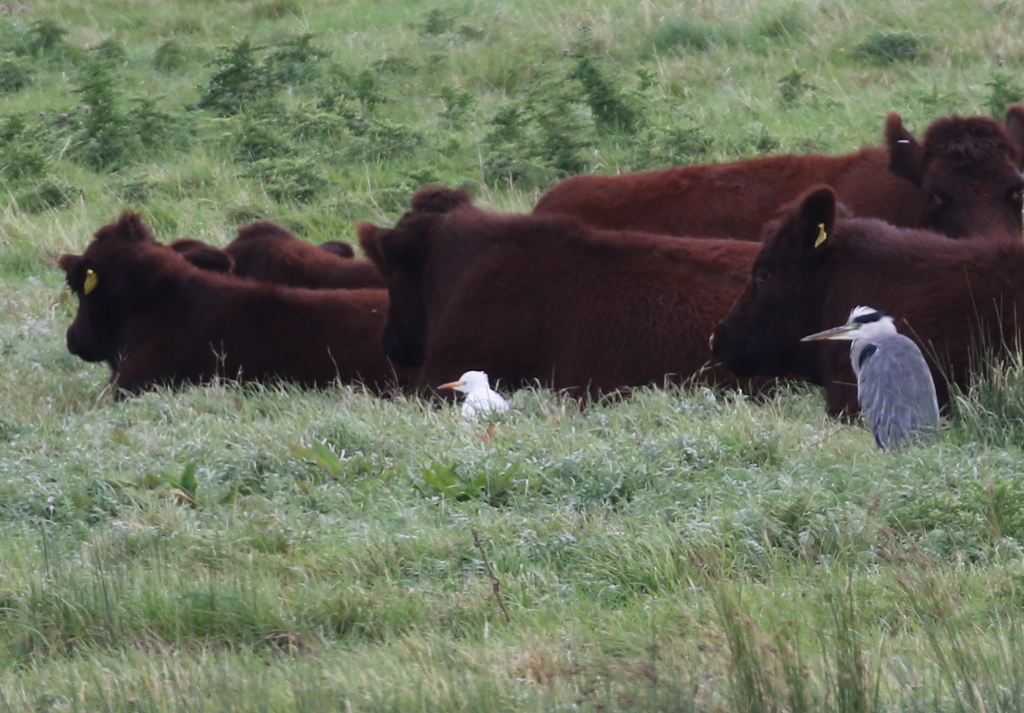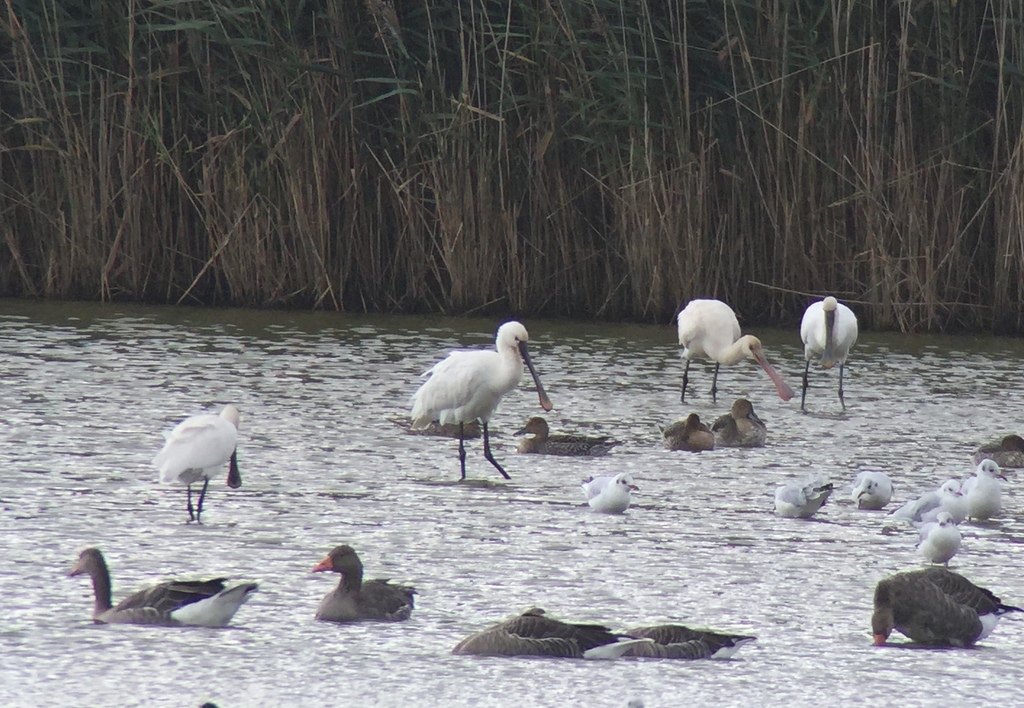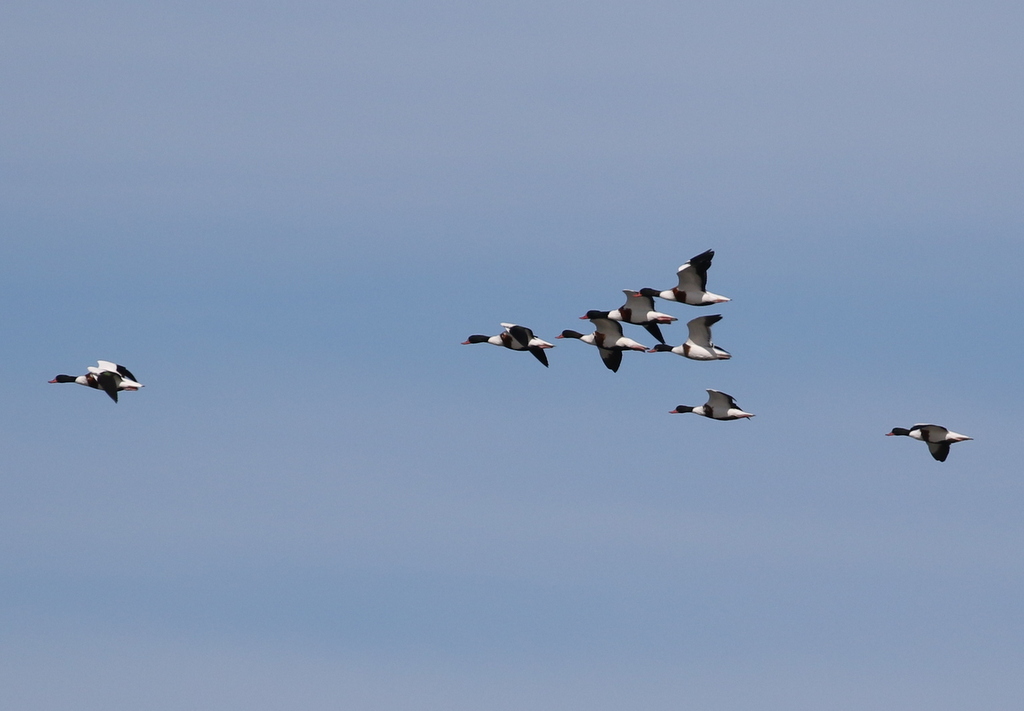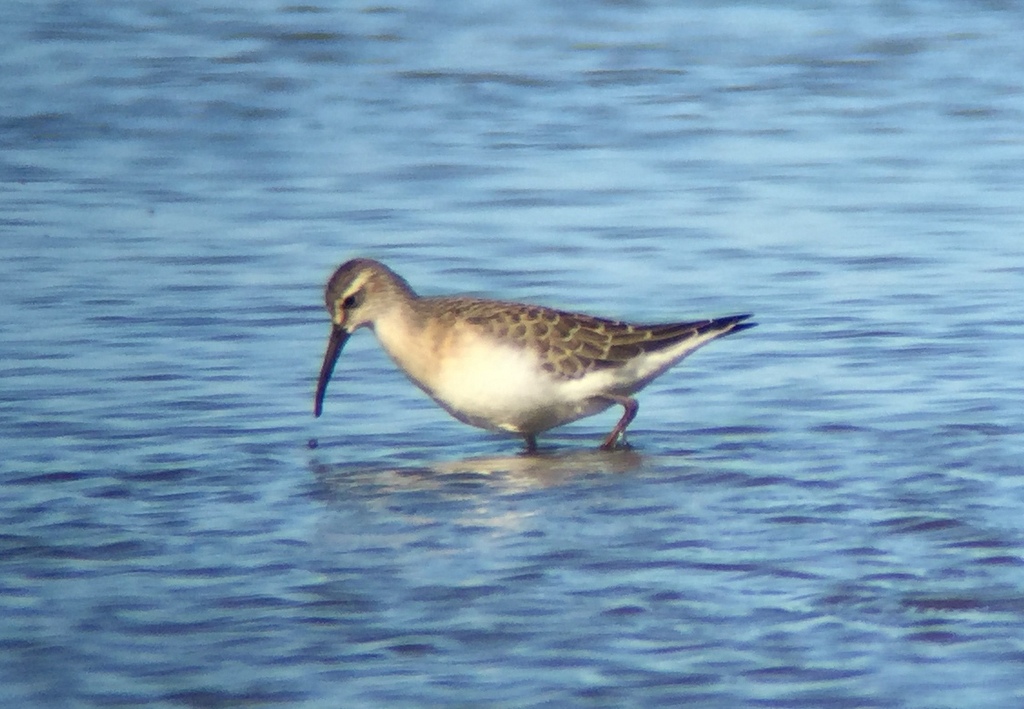A Private Tour today. It was to be a relaxed day of general birding on the North Norfolk coast. After getting caught by a brief shower first thing, the clouds cleared, the blue sky appeared and the sun came out. It was even quite warm by the end of the day. A lovely day to be out.
Our first stop for the morning was to be Stiffkey Fen. On our way there, we drove slowly past the wet meadows just east of the village, trying to work out where the cows were today. A Sparrowhawk came out of the hedge beside the road and flew low over the tarmac ahead of us before swooping up into a tree the other side. We eventually found the cows towards the eastern end of the meadow and even before we pulled up, we could see a white shape with them. It was a Cattle Egret.
 Cattle Egret – with the cows at Stiffkey again today
Cattle Egret – with the cows at Stiffkey again today
The Cattle Egret has been hanging around with the cows here on and off for a while now. We managed to stop the car for a minute, while there was no traffic, and have a look at it through binoculars. We could see its short yellow bill. A couple of Grey Herons were loafing next to the cows too.
After parking a little further along the road, we walked out towards Stiffkey Fen. A pair of Bullfinches were calling from the trees beside the road, but we couldn’t see them from the path. As we started down the footpath by the river, a Chiffchaff was calling above our heads and flitting about in the willows, and a Goldcrest appeared with it briefly too. We could hear Long-tailed Tits in the bushes by the river and caught the back of a mixed tit flock, with Blue Tits and Great Tits too. A Greenfinch and a Chaffinch flushed from the brambles as we walked past.
When we got to a gap in the trees where the brambles and reeds are low enough to see over, we had a look out across the Fen. The first thing we saw were the Spoonbills, nine of them. We had a quick look at them from here, then headed up onto the seawall for a better view. It was not long after we got up onto the seawall that it started to rain. We took shelter down by the sluice and thankfully it was just a brief shower.
From back up on the seawall, we had a good look at the Spoonbills. Some were asleep, as usual, but one was busy preening and when it lifted its head we could see its yellow-tipped black bill, an adult. Another two Spoonbills were walking around in the shallow water, one was an adult but the other was a juvenile with a fleshy-coloured bill. The juvenile was chasing behind the adult, bobbing its head up and down and begging for food. The adult kept trying to walk away, but there was no respite.
 Spoonbills – four of the nine on the Fen today
Spoonbills – four of the nine on the Fen today
The tide in the harbour was already half way out, so a lot of the waders had already left the Fen and gone out into the harbour to feed. There were several Redshanks down in the harbour channel below the seawall. We could hear Greenshanks calling, but couldn’t see them in their usual place on the Fen. They were hiding behind the reeds today, and the next thing we knew they flew up and over the seawall, heading off across the saltmarsh and out into the harbour. A Kingfisher flew the same way too, up from the river in front of us, across the reeds and over the seawall.
There were still a few waders left on the Fen, mostly Ruff which we had a look at through the scope. A Black-tailed Godwit was fast asleep in the middle of a big group of feeding Ruff. There was a single Avocet on here too today, looking slightly lonely.
A good number of Greylag Geese were scattered around the islands on the Fen and, in between them, we could see a variety of ducks. The drakes are mostly not at their best at the moment, in their rather drab eclipse plumage. We did manage to get a smart drake Gadwall in the scope, but it was just too far to appreciate the fine detail and complexity of its feather patterns. There are plenty of Teal and Wigeon on here now, in addition to all the Mallard. Over at the back, we found a small group of Pintail too.
At that point, something spooked all the birds on the Fen and most of them took to the air. We didn’t see what it was, there was no sign of a raptor about and it might have been the geese taking off noisily to head off to the fields, but whatever it was, by the time things settled down again, there were much fewer birds left behind. Many of the ducks and waders headed off to the harbour to feed, so we decided to head round that way ourselves.
As we walked round to the harbour, we could see several waders down on the mud in the channel. They were mostly Redshank, but in with them was a single Grey Plover, so we had a good look at it through the scope, already in its grey non-breeding plumage. When we got to the corner, we stopped to look at the harbour. A Greenshank flew up from the channel and off across the mud. We heard the Kingfisher call again and looked across to see it perched on the gunwale of one of the boats in the channel. We got it in the scope, but it didn’t stay long and flew off back up the channel.
 Blakeney Harbour & Point – after the sun came out
Blakeney Harbour & Point – after the sun came out
The sun was shining now and it was a fantastic view across the harbour to Blakeney Point beyond. We stood for a while and admired the view, while we scanned for birds out on the mudflats. Most of the waders were presumably further out, out of view down in the Pit. We could still see quite a few from here though – a nice selection including Oystercatchers, more Grey Plover, Black-tailed Godwits, a few Curlew and a little group of Turnstone.
Four Brent Geese flew in and landed distantly on the edge of the water down in the Pit. They have only just started to return from the Russian breeding grounds in the last couple of days and these are the first ones we have seen here this autumn. In a few weeks time, the area will be busy with them, but it was great to see the first ones return.
As we turned to head back, we bird call, a sound like two stones being knocked together, and turned to see a Stonechat perched on the top of a Suaeda bush on the edge of the saltmarsh. It was joined by a second Stonechat and the two of them gradually worked their way towards us, dropping down out of view, but returning to perch right on top of the bushes.
 Stonechat – one of a pair on the edge of the saltmarsh
Stonechat – one of a pair on the edge of the saltmarsh
On the walk back, with the sun out, there were several butterflies and dragonflies enjoying the warmth along the hedgerow beside the path, Red Admiral, Comma and Speckled Wood, Common Darter and Migrant Hawker. A Cetti’s Warbler shouted at us from deep in the bushes.
Our next destination was Cley and we set off to walk out along the East Bank. There were lots of geese out on the grazing marshes to the east, Greylags, Canadas and a few Egyptian Geese in with them too. We could hear Pink-footed Geese calling away in the distance, presumably birds just flying in, but we couldn’t see them.
We heard Bearded Tits too, calling from the reedbed, but they too remained elusive, keeping down out of the breeze. A Swallow flew low across the grazing marsh, over the bank and west on across the reeds. It was followed by several more. They are on their way down to Africa for the winter already, and these were the only hirundines we saw today. Autumn is definitely here already.
Scanning the wet grass down on the grazing marshes, we found quite a few waders, mainly Lapwings and Ruff. A single Common Snipe was busy probing away into the mud in amongst the tussocks, but then shuffled off out of view. At the north end of the Serpentine, we came across a small group of Dunlin out on the open mud. We were just looking at them when two Little Stints flew across to join them. We had a great view of the two species side by side in the scope.
 Little Stint – one of two juveniles on the edge of the Serpentine
Little Stint – one of two juveniles on the edge of the Serpentine
Arnold’s Marsh had a lot of birds on it, but they were mostly Black-tailed Godwits and Redshanks. A couple of Curlew were feeding at the back. Several Cormorants were drying their wings on the stony island. After resting our legs for a few minutes in the hide, we continued on to the beach. We could hear a Water Rail squealing from the north edge of the reedbed, tucked well in and out of view.
The sea looked quiet at first. A couple of distant Gannets flew past, low over the sea. Two Sandwich Terns flew across a bit closer in. There has been a lot of wildfowl returning in the past few days, and it wasn’t long before we picked up a single Brent Goose flying past offshore, with three Cormorants following close behind, taking advantage of it to make their short journey easier. A little while later, another 13 Brent Geese flew pas in a line, all just returning from their Russian breeding grounds for the winter.
A couple of large groups of Shelduck flew past over the sea too. The adult Shelducks fly off to the Wadden Sea to moult at the end of the breeding season. Once their moult is complete, they start to return here and these are some of the first to return. A couple of Curlew flew past too, also returning from Europe for the winter.
 Shelducks – returning after going to the Wadden Sea to moult
Shelducks – returning after going to the Wadden Sea to moult
We headed back for lunch back at the visitor centre, stopping on the way to admire the two Little Stints which were now busy bathing in a small pool on the edge of the grazing marsh. While we were eating our lunch, we noticed a large white shape circling over the hides. It was a Spoonbill and after a minute or so it flew off west.
After lunch, we headed out to the main hides. There had been a report of four Curlew Sandpipers on Simmond’s Scrape earlier, but when we got there we could only find one and it was on Pat’s Pool. It was nice and close though, so we had a good look at it through the scope, a juvenile with scaly patterned back and a peachy wash across the breast. After a few minutes, it flew back to join the Dunlin on Simmond’s.
 Curlew Sandpiper – feeding on Pat’s Pool and then Simmond’s Scrape
Curlew Sandpiper – feeding on Pat’s Pool and then Simmond’s Scrape
There were lots more Little Stints on Simmond’s Scrape too. They were rather hard to see at first, very small and creeping about on the low vegetation on the wetter islands, but the more we looked the more we found. In the end, we could see at least 9 Little Stints on the scrape, all juveniles. There were three Ringed Plover out on the islands too.
There were a few other waders on here too. Several Lapwing looked particularly irridescent in the sunshine, well worth a quick look through the scope at their glossy green, purple and bronze tinged upperparts. There were a few more Ruff here and a small group of Black-tailed Godwits half hidden in the deep water, with their heads under probing vigorously in the mud below. Three more Avocets were asleep on Pat’s Pool.
 Black-tailed Godwit – feeding in the deep water in front of the hide
Black-tailed Godwit – feeding in the deep water in front of the hide
There were a couple of Marsh Harriers which flew up over the reeds at the back of the scrape at one point. A Little Egret was feeding up and down on the water along the front edge.
As we walked back to the car, it was lovely in the sunshine, listening to the wind in the reeds. It was an early finish today, then back home to put our feet up.
















